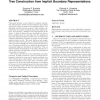Free Online Productivity Tools
i2Speak
i2Symbol
i2OCR
iTex2Img
iWeb2Print
iWeb2Shot
i2Type
iPdf2Split
iPdf2Merge
i2Bopomofo
i2Arabic
i2Style
i2Image
i2PDF
iLatex2Rtf
Sci2ools
SMA
2003
ACM
2003
ACM
Three-dimensional halfspace constructive solid geometry tree construction from implicit boundary representations
This paper presents a new method to compute constructive solid geometry (CSG) tree representations of an object whose faces consist of planar and non-planar surfaces. The algorithm described accepts as input a valid boundary representation of an object consisting of piecewise implicit surfaces, and computes a halfspace CSG representation of the object. A class of objects that are describable by the surfaces bounding them are valid input for the algorithm of this work, although methods currently exist to compute the additional information necessary to process non-describable quadric objects as well. This work builds on and complements the other work in this area, in which dominating halfspaces are used to simplify the b-rep to CSG conversion process. We include factored faces to enable the factorization of dominating halfspaces throughout the algorithm. Thus, an efficient disjoint decomposition of the solid is obtained as a matter of course in the algorithm, so that CSG minimization is...
| Added | 05 Jul 2010 |
| Updated | 05 Jul 2010 |
| Type | Conference |
| Year | 2003 |
| Where | SMA |
| Authors | Suzanne F. Buchele, Richard H. Crawford |
Comments (0)

